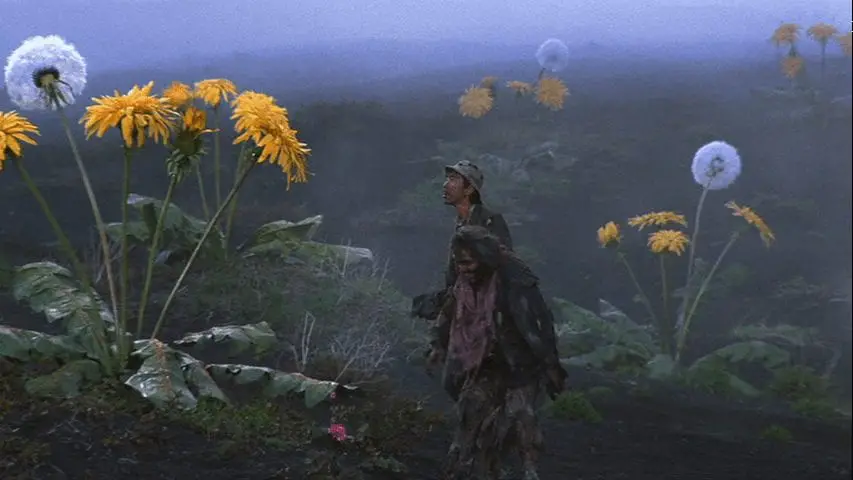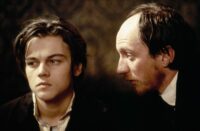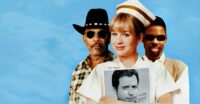In light of the release of the PlayStation exclusive Ghost of Tsushima, one of the most touted features was the inclusion of “Kurosawa Mode,” the game’s optional black and white colour grade made to replicate and tribute the iconic aesthetics of the Japanese master’s celebrated samurai epics. Akira Kurosawa was far from the only filmmaker of the pre-Eastman colour era to portray and critique Japan’s feudal past, nor did he cease from this period once colour arrived. In fact, two of his most celebrated and certainly most epic Samurai films—Ran and Kagemusha—were made in colour after his return from his absence from filmmaking in Japan in the 1970s. However, to the popular imagination, grave men with katanas drawn shot in austere black and white film are synonymous with Kurosawa, and he with them.
The fact remains though, that as fantastic as Throne of Blood, Seven Samurai and Rashomon are, in watching Kurosawa’s action epics one is only scratching the surface of his genius. Many of his most transfixing, resplendent and poignant works were contemporary dramas and period works, and are films which may be counted among the most touching, profound and humane artworks in all of cinema.
No Regrets for Our Youth (1946)
Though Kurosawa’s films made under Imperial rule do not noticeably lack for beauty or relevance and he never once made a bad film in his fifty-year long career—and Sanshiro Sugata II might even lay claim to being one of his most influential works, being as it was one of the earliest and best sports dramas, as well as the first film sequel to mark itself as such numerically—one of his earliest achievements was the graceful Post-War melodrama No Regrets for Our Youth. The film starred a young Setsuko Hara (who later found international recognition in her collaborations with Yasujiro Ozu) as Yukie, an academic’s daughter who falls for a socialist student who joins the resistance. Finding herself and his family ostracised when the war ends and those around them blame people such as they for losing them the war.
It’s one of many Post-War Japanese films that reassesses a sense of national priorities and of many such films that narrativise a return to nature and an agrarian lifestyle. Yukie’s efforts in aiding the Noge family to rebuild their farm after the war articulates a deep sense of humility and compassion and an attempt to nurture a dismayed and bereaved nation back to health and the film is shocking in its brave vilification of those who tore it apart and led it astray.
One Wonderful Sunday (1947)
Kurosawa returned to this process of healing with his next film, at once a darker and a more sentimental piece following a young couple teetering on the poverty line trying increasingly desperately to enjoy their weekly twenty-four hours of freedom together before returning to work on Monday. There’s more than a touch of Vittorio De Sica’s neorealist masterpiece Bicycle Thieves in the film’s style and narrative, as Yuzo and Masako flit from one locale to the next, counting their pennies and trying against the odds to stay positive. It’s a bleak and despairing tale culminating in a shocking moment of near sexual violence that leaves a lingering sense of betrayal and hopelessness.
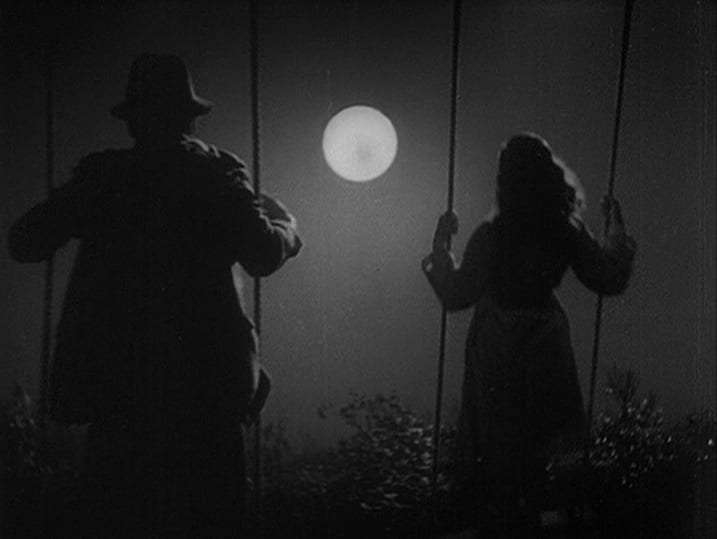
However, it is in the ending that Kurosawa makes perhaps the bravest and most sentimental move of his whole career, as Masako turns to address the audience, imploring them to applaud for the tender hearts of our heroes and urge them not to give up hope. In lesser hands, the moment would have been indescribably saccharine. Yet, for Kurosawa, it emerges as one of the most intensely emotional moments in his whole canon, and one that brings tears even to recall.
Stray Dog (1949)
Possibly the richest and most rewarding run of artistic collaborations between actors and director began in 1948 with Drunken Angel, which brought together for the first time not only Kurosawa and regular leading man Toshiro Mifune but his co-star Takashi Shimura, with whom Kurosawa would make no fewer marks on the cinematic map. As great as Drunken Angel and its follow up The Silent Duel undoubtedly are, it was their third collaboration that makes it onto this list, the taut police procedural that solidified the three-way partnership, Stray Dog.
The mentor-disciple dynamic that would recur throughout Kurosawa’s career was firmly in place here, casting Mifune as a proud but green young rookie partnered with Shimura’s wise older detective to recover the pistol Mifune has lifted from him while off duty and which is used in a string of increasingly abhorrent crimes. As the sense of guilt and personal responsibility weighs heavier on Mifune’s junior officer as he pursues the killer prowling the heatwave-besieged city, the film slowly marches towards its intense, nail-biting climax. It’s a superb example of genre filmmaking from Kurosawa, featuring career-defining roles from its two leads, whilst retaining his unique dramatic voice.
Ikiru (1952)
As previously stated, I don’t believe there’s a single Akira Kurosawa film that isn’t worth your time. However, if pressed to nominate a single film which I might elevate to declare his finest hour, then on nine days out of ten it would be Ikiru, his sweeping yet infinitesimally intimate meditation on mortality and moral purpose featuring an absolutely astonishing central performance from Takashi Shimura as doomed pencil pusher Kanji Watanabe.

Having spent his entire life as a desk blocking bureaucrat, lonely widower Watanabe is deeply disturbed when he is diagnosed with stomach cancer. Sentenced to soon become non-existent, he begins flailing, desperately seeking to give his final days on earth purpose and meaning before finally latching onto the simple goal of converting a patch of waste ground into a municipal park.
Though it would be worth watching solely for the extraordinary performance of Shimura, Ikiru is one of Kurosawa’s most touchingly complete films. Both richly patterned with subtext and symbolism yet fantastically direct and accessible, it embodies a humanistic and altruistic ethos and the preciousness of every instant spent on earth as well as any other film in existence.
I Live in Fear (1955)
Although the national trauma of the atom bomb hung low over cinema the world over in the years following the commencement of the nuclear age, few Japanese films of the era gave such a name to this fear. Most nuclear films of the time transformed this threat into rampaging lizard men or mutant monsters from the depths of the ocean. As the directness of its title suggests though, I Live in Fear is not coy about what it addresses. It’s unsubtle to the point you begin to wonder at its being analogous for broader fears of death in general, or perhaps today, to political corruption or climate change?
The film once again reunites Kurosawa with Shimura and Mifune, the latter playing an ageing industrialist patriarch who, consumed with nuclear paranoia, intends to spend his fortune decamping his horrified family to South America, where they might be safe from the threat of nuclear Armageddon. Perhaps the film may feel unpalatable to some as Mifune is playing a character many decades his senior. Nonetheless, he gives an unforgettably warped, commanding and manic performance—hunched, shadowing and bursting with intensity, his makeup stained eyes jumping at lightning. It’s also one of Kurosawa’s most memorably sparse uses of music, bracketing the film with a smoky jazz quintet, featuring an unstable, querulous theremin stealing into the mix.
The film’s cerebral treatment of its provocative themes is highly predictive of the likes of Andrei Tarkovsky’s The Sacrifice, Paul Schrader’s magnificent First Reformed, and even Anthony Shaffer’s Equus, as it asks the horrifying question, ‘is this man insane for being obsessed by the end of the world, or are we all insane for not being?’
The Bad Sleep Well (1960)
Two of Kurosawa’s most celebrated samurai epics, Ran and Throne of Blood transposed Shakespeare plays to Feudal Japanese settings. The resultant films were monumental epics but not the only time Kurosawa drew on Shakespeare for inspiration. One other such treatment was this extraordinary gothic corporate thriller that loosely adapted Hamlet for the backstabbing world of modern capitalism, starring Toshiro Mifune as the loyal young executive who plots to infiltrate the board of the company that killed his father and bring it down from the inside.
The resulting work is one of Kurosawa’s angriest and most political works, with a bleak climax that speaks of an unbridled moral outrage at the amoral capitalist system and is as much The Great Gatsby as Hamlet. Once again, the film is anchored by tremendous performances, particularly from Mifune. Dressed in a suit, with neatly parted hair and spectacles, it’s about as far from his samurai savages as one could get, possessed with an assured coldness and singularity of purpose. Yet, he still commands an extraordinary magnetism and comes off as much of a force of nature as ever.
High and Low (1963)
For what is, in my opinion, Mifune’s finest hour though, we must turn to the nail-biting abduction thriller High and Low—more literally ‘Heaven and Hell.’ Often described as Prisoners before Prisoners, the film follows Mifune’s dignified businessman who is forced to make an anguished choice between saving the life of a young boy and saving from ruin the business empire he spent his whole life building when his chauffer’s son is held to ransom, the kidnappers having mistaken the boy for Mifune’s child. The scene halfway through where he carries out his decision is possibly the most agonising of Kurosawa’s career, as Mifune is forced to throw his life’s savings from a moving train.
The latter half that follows shifts its focus from Mifune’s executive to Tatsuya Nakadai’s detective in charge of tracking down the kidnappers and the film morphs into a taut, high-stakes procedural as his officers comb the city slums in search of the ruthless criminal behind the abduction. Despite the more intimate scale, the film is at times unbearably tense. As it transitions from the almost play-like airy one-room setting of Mifune’s hilltop mansion to the sprawling, labyrinthine, sweltering streets below, it showcases some of the most stunning and dynamic noir cinematography of regular collaborator Asakazu Nakai’s career.
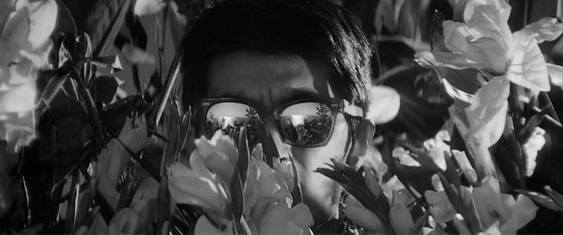
Red Beard (1965)
As fruitful as the Kurosawa-Mifune collaboration had been, the relationship grew increasingly fractious as Mifune grew increasingly impatient with Kurosawa, who was taking longer and longer to complete each film. The two finally parted ways when Kurosawa’s two-year-long shoot for Red Beard forced Mifune to pass on other roles and left him unable to shave his character’s signature beard. It’s fortunate though that with Red Beard, the two ended with possibly their greatest work.
An adaptation of a series of short stories by Shugoro Yamamoto centring on a provincial 19th Century hospital, the film follows Yuzo Kayama’s arrogant novice medical student Yasamoto, assigned to earn his stripes at the rural clinic of the unconventional Doctor ‘Red Beard,’ played with sage authority by Mifune. The film’s episodic story follows a year in the life of a country hospital and its beleaguered staff as they tend to the needs of its impoverished patients.
Although principally focused on the relationship between the stubborn pride of the young novice and the sage paternal wisdom of Red Beard, and the respect the former comes to hold, there are numerous subplots, fleshed out into a narrative. Whether told as a deathbed confession or an overheard conversation between two damaged children, these stories expose the richness and sadness that lives behind the eyes of every character.
The film deals with dark, tragic themes, encompassing insanity, suicide, trauma, poverty, physical and sexual child abuse, and their effects on the soul. The scenes of sickness and surgery are shown in stark, agonising detail, one extraordinary sequence where Yasumoto is left alone to tend a dying man is excruciating in its discomfort, but are offset by their emotional resonance. Afterwards, Yasumoto asks how witnessing a man’s final moments of life could ever be described as solemn, but then after hearing the dying man’s story, he recalls the incident in a new light, seeing the humanity in him and the result is astonishingly powerful.
Alongside Ikiru, this is perhaps Kurosawa’s most eloquent articulation of his humanist ethos as embodied by the eponymous Red Beard. As stern and stoic as any of Mifune’s roles, he even has one of his trademark brawl scenes, yet Red Beard—both the character and the film—projects a message of empathy, wisdom and humility in every kind action.
Dersu Uzala (1975)
As previously suggested, as he grew into his later years, Kurosawa began putting his eggs into fewer baskets, making fewer films, each one more ambitious than the last. However, after the commercial and critical failure of Dodes’ka-den his most bizarre and loose-knit film, he abandoned Japan and for the rest of the 1970s made work in Russia, resulting in a single completed work, Dersu Uzala.
Though based on a canonical Russian novel, shot in a foreign country and a second language, Dersu Uzala is as distinctively Kurosawa as any single film he made. While a gentlemanly Russian officer is an expedition to map the forbidding Taiga forest, he meets Dersu, an eccentric, almost childlike fur trapper with a comprehensive knowledge of the frontier and unique respect and affinity for the natural world around him. As the years pass the two form a lifelong friendship which turns to tragedy as the years begin to leave their mark on Dersu and the frontier itself.
A touching and soulful meditation on ageing, civilisation and progress as told in a punchy, mystical adventure story, Dersu Uzala is a true epic in every sense of the word.
Dreams (1990)
The final film on this list is particularly close to my heart. In my personal ranking of Kurosawa’s work, it’s a mere close second to Ikiru. The film is an intensely intimate exploration of Japanese folklore and tradition filtered through the unique gaze of Kurosawa’s subconscious. The film tells eight loose stories, each one supposedly inspired by a dream Kurosawa once had. Some lead directly into one another; many share the same protagonist. This young man closely resembles Kurosawa himself, and there is a recurring motif of stately procession—a wedding march, a funeral procession, a group of mountaineers following one another’s backs, a military parade, a crowd fleeing a volcano—each one representing a different rite of passage, but always in some way tied to death.
The film captures the essence of a dream and occasionally of a nightmare perfectly. It might be the most gorgeous live-action film I’ve ever seen. Every aspect of this film, from the cinematography and the production design to the sound design and the music, would be incredible alone, put together they create a surreal, transcendent, and absolutely unforgettable experience.
